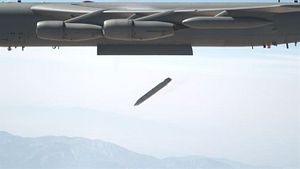U.S. Forces Korea (USFK) purportedly deployed over ten Joint Air-to-Surface Standoff Missiles (JASSM) at Kunsan Air Base, located west of Gunsan City in North Jeolla Province, around 180 kilometers south of Seoul, according to South Korean media reports.
Multiple defense sources confirmed on Monday that the long-range precision-guided missiles have been deployed and that U.S. forces are planning to conduct a JASSM live-fire exercise in the event of a sixth North Korean nuclear test. “To my knowledge, the USFK considers making public a live-fire drill involving the JASSM in case North Korea carries out another strategic provocation, such as a sixth nuclear test,” a source told Yonhap news agency.
The Lockheed Martin AGM-158 JASSM stand-off cruise missile is a long-range, radar-evading cruise missile designed to destroy hostile air defenses and high value, well defended, fixed and relocatable targets while keeping aircraft safely out of range from hostile air defense systems. Armed with a penetrator/blast fragmentation warhead, the operational range of the missile is estimated at over 370 kilometers (230 miles).
According to Lockheed Martin, the missile’s “stealthy airframe makes it extremely difficult to defeat.” JASSM has so far been integrated on the B-1B, B-2A, B-52H, F-16, and F-15E. It is unclear what variant of the JASSM has been deployed to Kunsan Air Base. A new missile variant, the Joint Air-to-Surface Standoff Missile – Extended Range (JASSM-ER) has more than two-and-a-half times the operational range of the baseline JASSM and is purportedly capable of engaging targets up to 1,000 kilometers (620 miles) away.
South Korea and the United States have been stepping up their precision strike capabilities over the last years as part of a strategy to deter North Korean military action, known as the Korea Massive Punishment & Retaliation (KMPR) plan. As I explained elsewhere:
In the event of a North Korean nuclear attack (or even signs of preparations for one), KMPR specifically calls for surgical strikes against key leadership figures of the communist regime and military infrastructure with the missiles part of a so-called kill chain consisting of integrated information, surveillance, and strike systems, as well as the Korea Air and Missile Defense (KAMD) system.
JASSM will be an integral part of the kill chain, next to indigenous South Korean weapons systems. As I reported last Friday, South Korea recently tested a new land-launched ballistic missile with an estimated range of 800 kilometers. The new missile, likely to be designated the Hyunmoo 2c, will be operational at the end of the year.

































